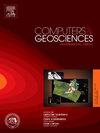基于语义分割的数字高程模型谷底提取方法
IF 4.4
2区 地球科学
Q1 COMPUTER SCIENCE, INTERDISCIPLINARY APPLICATIONS
引用次数: 0
摘要
从数字高程模型(dem)中准确提取山谷底部对山地景观的水文和地貌分析至关重要。然而,阈值设置依赖于人工干预;靠近谷底的道路与谷底特征相似,阈值不能有效适应各种形状的山谷,导致现有方法的提取精度较低,特别是在窄v型山谷中。为了解决这些问题,本研究开发了一种语义分割方法,称为基于密集的注意合并上下文引导网络(DAM-CGNet)。该方法在不依赖阈值的情况下,有效地排除了山坡上的道路,增强了对山谷边界陡峭特征变化的识别,能够提取各种形状的谷底。主要改进包括:(1)引入卷积块注意模块(CBAM)增强信息流中的特征重用,采用注意机制抑制无关特征响应,关注谷边界特征;(2)利用DenseNet的密集连接策略重建特征流,帮助模型在深层保留重要的谷底细节,更好地识别小而窄的谷;(3)通过评估各种输入组合来解决单通道DEM表示的局限性,最终选择DEM、地形位置指数(TPI)和坡度作为提取谷底的有效输入。使用语义分割模型和传统方法进行的实验验证了该方法的有效性。具体而言,DAM-CGNet在测试集上取得了较高的准确率(MPA: 90.15%, MIoU: 84.18%, FWIoU: 92.99%),在提取各种形状的谷底方面优于传统方法。该方法不需要像传统方法那样手动设置阈值,提高了谷底提取精度,为后续谷底宽度计算提供了新的视角。本文章由计算机程序翻译,如有差异,请以英文原文为准。
DAM-CGNet: Semantic segmentation-based approach for valley-bottom extraction from digital elevation models
The accurate extraction of valley bottoms from digital elevation models (DEMs) is crucial for hydrological and geomorphological analyses of mountainous landscapes. However, threshold settings rely on manual intervention; roads near valley bottoms resemble valley-bottom features, and thresholds cannot effectively adapt to valleys of various shapes, leading to low extraction accuracy in existing methods, particularly in narrow V-shaped valleys. To address these issues, this study developed a semantic segmentation approach called a Dense-based Attention Merging Context Guided Network (DAM-CGNet). Without relying on thresholds, this method effectively excludes roads on hillslopes and enhances the recognition of steep feature changes at valley boundaries, enabling the extraction of valley bottoms of various shapes. Key improvements include: (1) incorporating the convolutional block attention module (CBAM) to enhance feature reuse in the information flow, employing attention mechanisms to suppress irrelevant feature responses and focus on valley boundary features; (2) using the dense connection strategy of DenseNet to rebuild the feature flow, helping the model keep important valley-bottom details in deep layers and better recognize small and narrow valleys; and (3) addressing the limitations of single-channel DEM representation by evaluating various input combinations, ultimately selecting DEM, topographic position index (TPI), and slope as effective inputs for valley-bottom extraction. Experiments using semantic segmentation models and conventional methods validated the effectiveness of the proposed method. Specifically, DAM-CGNet achieved high accuracy on the test set (MPA: 90.15 %, MIoU: 84.18 %, FWIoU: 92.99 %) and outperformed conventional methods in extracting valley bottoms of various shapes. This method, without a manual threshold setting as in conventional approaches, enhances valley bottom extraction precision and provides a new perspective for subsequent valley bottom width calculations.
求助全文
通过发布文献求助,成功后即可免费获取论文全文。
去求助
来源期刊

Computers & Geosciences
地学-地球科学综合
CiteScore
9.30
自引率
6.80%
发文量
164
审稿时长
3.4 months
期刊介绍:
Computers & Geosciences publishes high impact, original research at the interface between Computer Sciences and Geosciences. Publications should apply modern computer science paradigms, whether computational or informatics-based, to address problems in the geosciences.
 求助内容:
求助内容: 应助结果提醒方式:
应助结果提醒方式:


